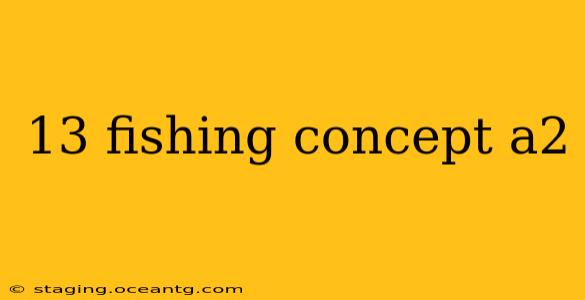13 Fishing Concepts: A Beginner's Guide (A2 Level English)
This article explores thirteen fundamental fishing concepts, explained in simple terms for beginners. Whether you're just starting your fishing journey or looking for a refresher, this guide will help you understand the basics and improve your fishing skills.
1. What is Fishing?
Fishing is the activity of catching fish. This can be done in many ways, from using a simple rod and line to employing more sophisticated techniques. It's a popular hobby enjoyed by millions worldwide, offering relaxation, a connection with nature, and the thrill of the catch.
2. Types of Fish: Freshwater vs. Saltwater
Fish live in both freshwater (like rivers and lakes) and saltwater (like oceans and seas). Freshwater fish, such as trout and bass, have different requirements than saltwater fish, like tuna and cod. Knowing the type of fish you are targeting is crucial for choosing the right location and bait.
3. Fishing Equipment: The Basics
Basic fishing equipment includes a fishing rod, a fishing reel, fishing line, hooks, and bait or lures. Understanding how to use this equipment is essential for successful fishing. There are many different types of rods, reels, and lines, each suited to different fishing styles and types of fish.
4. Bait: Attracting Your Catch
Bait is used to attract fish. This can include live bait (like worms or minnows), artificial lures (that mimic the appearance of prey), or even prepared baits (like dough balls). Choosing the right bait depends on the type of fish you're targeting and the conditions.
5. Lures: Mimicking Prey
Lures are artificial baits designed to mimic the movement and appearance of small fish or insects. They come in various shapes, sizes, and colors, each designed to appeal to different species. Learning how to work a lure effectively can significantly improve your catch rate.
6. Fishing Techniques: Casting and Retrieving
Casting is the act of throwing your line into the water. Retrieving is the act of reeling your line back in. Different techniques exist for casting and retrieving, depending on the type of bait and the type of fish you're targeting. Practice is key to mastering these skills.
7. Knots: Securing Your Line
Various knots are used in fishing to securely attach the line to the hook, the lure, and the fishing rod. Learning a few essential knots, such as the clinch knot and the improved clinch knot, is crucial for preventing line breakage.
8. Hooks: Catching the Fish
Hooks are used to catch the fish. Different types of hooks are designed for different types of bait and fish. The size and shape of the hook should be appropriate for the size of the fish you're targeting.
9. Fishing Locations: Where to Find Fish
Finding the right fishing location is essential for success. Different fish prefer different habitats. Some fish prefer deeper water, while others prefer shallow water near the shore. Researching your chosen location will help you identify good spots.
10. Understanding the Weather: Impact on Fishing
Weather conditions significantly impact fishing. Wind, rain, and temperature can all affect fish behavior and your ability to fish effectively. Checking the weather forecast before you go fishing is a good idea.
11. Fishing Regulations: Rules and Licenses
Most areas have fishing regulations that must be followed. These regulations often include size limits, bag limits, and licensing requirements. It's essential to understand and follow these regulations to ensure sustainable fishing practices.
12. Fish Handling and Release: Respecting the Environment
Proper fish handling is crucial, especially if you intend to release the fish. Handling fish gently and quickly reduces stress and improves their chances of survival. Learn about catch-and-release techniques to minimize your impact on the environment.
13. Patience and Persistence: The Keys to Success
Fishing requires patience and persistence. Don't get discouraged if you don't catch anything immediately. Keep practicing, experimenting with different techniques, and learning from your experiences. The thrill of the catch makes it all worthwhile!
This comprehensive guide provides a solid foundation for beginners. Remember to always prioritize safety and respect for the environment while enjoying the rewarding hobby of fishing.
